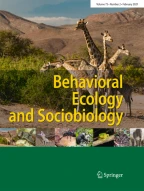Summary
In this paper we present an individualoriented model of the behaviour of bumble bees on the comb. We show that the combination of the population dynamics of a bumble bee colony and simple behaviour of the adult bees on the comb is sufficient to generate the social interaction structure of the colony (and it ontogeny) as observed by van Honk and Hogeweg (1981); the latter studied the dominance interactions in a captive Bombus terrestris colony in relation to worker oviposition by pattern analysis techniques. We also demonstrate how the generated/observed interaction structure can cause a switch from the production of worker offspring to the production of generative offspring.
The model is an application of the MIRROR modelling strategy (Hogeweg and Hesper 1979, 1981a, b, c). In this modelling strategy the emphasis is on (i) local definition of entities (individuals), (ii) experience-based interrelations between individuals and (iii) observability. Such models enable us to generate the ‘macro’ behaviour (in casu of bumble bee colonies) from the ‘micro’ behaviour (in casu of individual bees) without including (implicitly or explicitly) assumptions about macro relations in the specification of the behaviour of the individuals. Thus the model shows that only those features of the behaviour of the individual bees explicitly incorporated in the model specification are needed to generate the observed organisational pattern in the nest. The model does not, of course, rule out the possibility that other factors play a role in the organisation of live colonies.
Similar content being viewed by others
References
Brian MV (1968) Regulation of sexual reproduction in an ant society. Colloq Int CNRS 173:61–76
Doorn A van, Hogeweg P (1982) Die Entwicklung des agonistichen Verhaltens innerhalb der Arbeiterinnenkaste und zwischen Arbeiterinnen und der Königin während der Volksentwicklung bei der Erdhummel. Bombus terrestris. Mitt Dtsch Ges Allg Angew Entomol (in press)
Gower JC (1966) Some distance properties of latent root and vector methods used in multivariate analysis. Biometrika 23:623–627
Hogeweg P, Hesper B (1979) Heterarchical, selfstructuring simulation systems: concepts and applications in biology. In: Zeigler BP, Elzas MS, Klir GJ, Ören TI (eds) Methodologies in systems modelling and simulation. North-Holland, Amsterdam, pp 221–231
Hogeweg P, Hesper B (1981a) Selfstructuring simulation systems. In: Oren TI (ed) CYBERSOFT 80 International Symposium on Cybernetics and Software, Doc, no 4. International Association for Cybernetics. Namur, pp 63–74
Hogeweg P, Hesper B (1981b) On the role of OBSERVERS in large scale systems. In: UKSC Conference on Computer Simulation, Westbury IIouse, Harrogate, pp 420–425
Hogeweg P, Hesper B (1981c) Two predators and one prey in a patehy environment an application of MICMAC modelling. J Theor Biol 93:411–432
Hogeweg P (1983) Heterarchical systems as simulation modelling formalism. In: Singh M (ed) Encyclopedia of systems and control. Pergamon Press, Oxford
Honk CJG (1981) The social structure of bumble-bee colonics, Thesis, RU Utrecht
Honk CJG van, Velthuis HHW, Röseler PF, Maloteaux ME (1980) The mandibular glands of Bombus terrestris queens as a source of queen pheromones. Entomol Exp Appl 28:191–198
Honk CJG van, Hogeweg P (1981) The ontogeny of the social structure in a captive Bombus terrestris Colony. Behav Ecol Sociobiol 9:111–119
Michener CD (1974) The social behaviour of the bees. A comparative study. The Belknap Press of Harvard University Press, Cambridge (Massachusetts)
Oster GF (1976) Modelling social inscet populations. I. Ergonomics of foraging and population growth in bumble bees. Am Nat 110:215–245
Oster GF, Wilson EO (1978) Caste and ecology in the social insects. Princeton University Press, Princeton (New Yersey)
Pendrel BA, Plowright RC (1981) Larval feeding by adult bumble bee workers (Hymenoptera: Apidae). Behav Ecol Sociobiol 8:71–76
Plowright RC, Pendrel BA (1977) Larval growth in bumble bees (Hymenoptera: Apidae). Can Entomol 109:967–973
Röseler PF (1970) Unterschiede in der Kastendetermination zwischen den Hummelarten Bombus hypnorum and Bombus terrestris. Z Naturforsch 25b:543–548
Röseler PF (1974) Vergleichende Untersuchungen zur Oogenese bei weiselrichtigen und weisellosen Arbeiterinnen der Hummelart Bombus terrestris. Insectes Soc 21:249–274
Röseler PF, Röseler I (1977) Dominance in bumblebees. VIIIth Int Congr IUSSI. Wageningen
Röseler PF, Röseler I, Honk CJG van (1981) Evidence for the inhibition of corpora allata activity in workers of Bombus terrestris by pheromone of the queens mandibular glands. Experientia 37:348–351
Seeley TD (1982) Spatial efficiency and the volution of temporal polyethism in honeybec colonies. In: Breed MJ, Michener CD, Evans HE (eds) The biology of social insects. Westview Press, Boulder (Colorado)
Teitelman W (1974) Interlisp reference manual. Xerox, Palo Alto
Trivers RL, Hare H (1976) Haplodiploidy and the evolution of social insects. Science 191:249–263
Author information
Authors and Affiliations
Rights and permissions
About this article
Cite this article
Hogeweg, P., Hesper, B. The ontogeny of the interaction structure in bumble bee colonies: A MIRROR model. Behav Ecol Sociobiol 12, 271–283 (1983). https://doi.org/10.1007/BF00302895
Received:
Accepted:
Issue Date:
DOI: https://doi.org/10.1007/BF00302895
